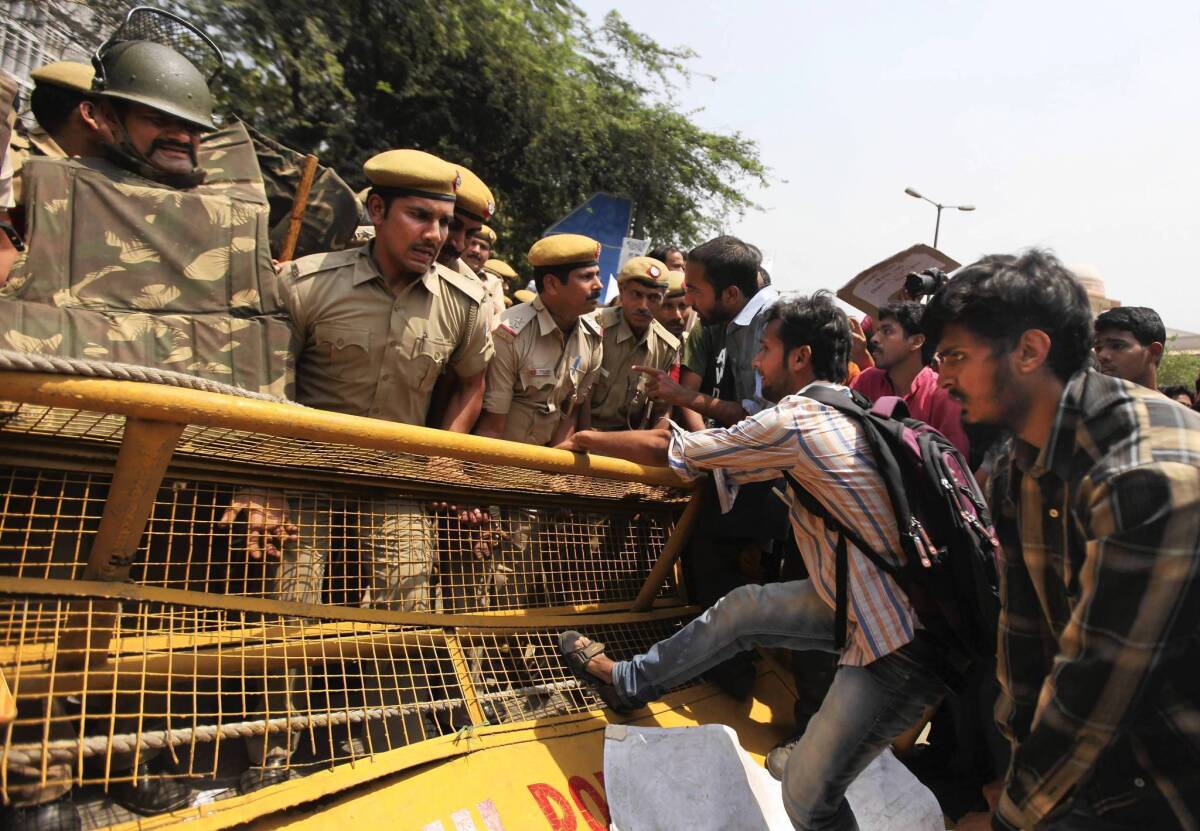Rape of 5-year-old ignites furious protest in India

NEW DELHI — Several hundred people protesting the rape and kidnapping of a 5-year-old girl descended on police headquarters Saturday, waving signs, overrunning barriers and calling for the resignation of the capital city’s police commissioner.
The angry demonstration, which spread to a hospital and the homes of two senior officials, was reminiscent of the outcry seen after a 23-year-old student was brutally raped and killed in December, a crime that shook the nation and led to tougher laws and the creation of special courts for rape cases.
Police on Saturday arrested Manoj Kumar, 22, who had reportedly fled to the central impoverished state of Bihar after the attack on the 5-year-old. Authorities said he was being returned to New Delhi to face rape, kidnapping and attempted murder charges. He reportedly lived in the same building as the young victim.
Public anger has been directed at police who, according to news reports, offered the child’s family $40 to keep quiet and told them they were lucky their child was alive. In addition, video showed a policeman slapping a female protester.
Sushil Kumar Shinde, India’s home minister, said an official inquiry would consider allegations of police negligence. A judge on Saturday imposed restrictions on public assemblies around India Gate, a monument and popular protest site in the capital.
According to police and local news reports, the 5-year-old went missing Monday evening while playing in front of the building where her family lives in a New Delhi slum. Police said the child was taken to another apartment in the building, and over a 40-hour period was attacked, strangled and left for dead before neighbors heard her cries.
The suspect, who was reportedly recently married, was described as a garment factory worker who lived with his father, a juice seller. He fled after the attack to his in-laws’ hometown in Bihar and was apprehended with the help of cellphone records, authorities said.
Doctors at the state-run All India Institute of Medical Sciences hospital told reporters that the child’s condition was stable and she was “conscious and alert,” but her wounds were infected and she could require corrective surgery.
The victim’s name will not be released because of her age and the nature of the crime, but the Indian news media have dubbed her Masoom, or “Innocent.”
The brutality of the attack has shocked the nation.
B.N. Bansal, a doctor with Swami Dayanand Hospital, where the victim was first taken for treatment, told reporters Friday that early, effective treatment was essential. He said the child had bruises on her lips, cheeks, arms and lacerations around her neck.
According to the New Delhi-based Asian Center for Human Rights, 48,338 child rape cases have been reported in India in the last decade. Of those, 7,112 were reported in 2011, compared with 2,113 in 2001. Experts say many other cases go unreported because of social stigma and fear that police will ignore, belittle or turn against the victim.
Prime Minister Manmohan Singh said in a statement Saturday that he was deeply disturbed by the latest incident. His government came under criticism for its lumbering response and defensive stance after the attack on the 23-year-old physiotherapy student in mid-December.
In that case, which led to weeks of protests, the woman was gang-raped while riding a bus home from a movie with her male companion, who was also badly beaten. The two were thrown from the bus, and the woman died two weeks later of her injuries in a Singapore hospital.
Analysts say it’s difficult to pinpoint why New Delhi, dubbed India’s rape capital by the news media, has seen more rapes than other major cities, such as Mumbai and Kolkata.
Though all major Indian cities have had a rapid influx of people from rural areas that has led to a clash of values, New Delhi was slower to industrialize and is less accustomed to women working, walking alone at night or otherwise acting independently, said Urvashi Butalia, a historian and women’s rights activist.
“But that doesn’t explain everything,” she said, such as why someone would attack a young child. “At an emotional level it’s horrific, and something that enrages and infuriates you.”
Tanvi Sharma in The Times’ New Delhi bureau contributed to this report.
More to Read
Start your day right
Sign up for Essential California for news, features and recommendations from the L.A. Times and beyond in your inbox six days a week.
You may occasionally receive promotional content from the Los Angeles Times.






